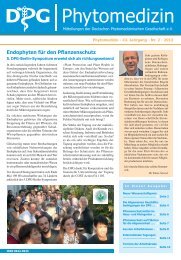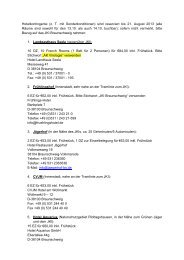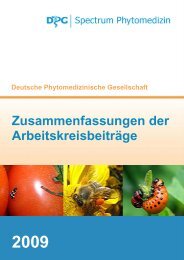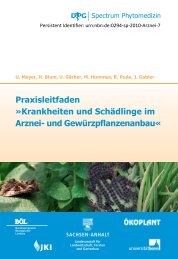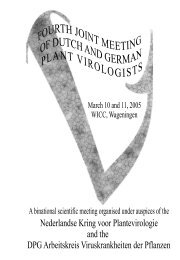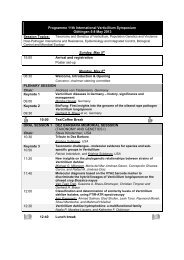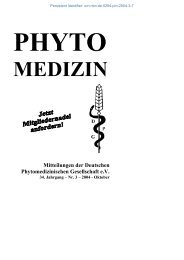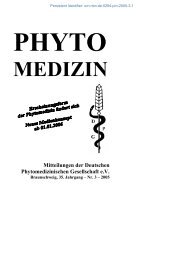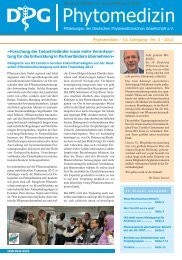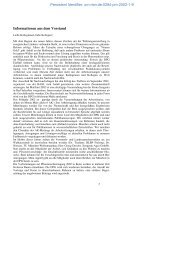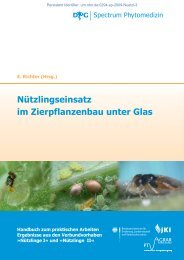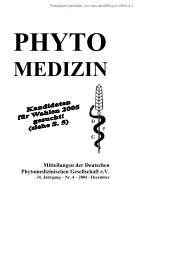Zusammenfassungen der Arbeitskreisbeiträge - Die DPG
Zusammenfassungen der Arbeitskreisbeiträge - Die DPG
Zusammenfassungen der Arbeitskreisbeiträge - Die DPG
Erfolgreiche ePaper selbst erstellen
Machen Sie aus Ihren PDF Publikationen ein blätterbares Flipbook mit unserer einzigartigen Google optimierten e-Paper Software.
sugars that were both locally and systemically strongly<br />
enriched after nematode infection is trehalose. A. thaliana<br />
trehalose 6-phosphate synthase genes (AtTPS), which play<br />
a role in catalysing trehalose, were significantly up regulated<br />
in H. schachtii infected plants. On the plant parasitic<br />
nematode (PPN) side, there is only little information about<br />
the TPS genes. Analysis of TPS genes of M. incognita<br />
(MINC) and M. hapla (Mh) showed an over-representation<br />
of TPS in comparison with the TPS from free-living nematodes<br />
(FLN) and animal-parasitic nematodes (APN). We<br />
identified 6 MINC-TPS and their Mh-TPS homologues while<br />
FLN-TPS have typically two TPSs, TPS-1 and TPS-2. TPS<br />
phylogenetic tree, which was formed using the available<br />
nematode TPS showed that there is only one of MINC-TPS<br />
and its M. hapla homologue that clustered with FLN- and<br />
APN-TPS-2. All other MINC- and Mh-TPS clustered in a<br />
separate branch. We conclude that the latter TPS have<br />
evolved in Meloidogyne spp. or generally in PPN species to<br />
fulfil functions related to pathogenicity. The gene that clustered<br />
with TPS-2 might still represent the ancestral TPS<br />
functions in FLN and APN. Furthermore, our analysis<br />
showed that two MINC-TPS have a predicted signal peptide.<br />
Interestingly, these MINC-TPS genes were included un<strong>der</strong><br />
the PPN specific branch. We expect that further studies on<br />
the PPN-TPS genes can help us gaining more un<strong>der</strong>standing<br />
about evolutionary processes in PPN.<br />
Damage and reproduction potentials of Egyptian<br />
populations of Hetero<strong>der</strong>a avenae on wheat<br />
Mohamed Baklawa 1,2 & Björn Niere 1<br />
1 Julius Kühn Institute, Institute for National and<br />
International Plant Health, Messeweg 11/12,<br />
38401 Braunschweig, Germany;<br />
2 Technical University, Faculty of Life Science,<br />
Braunschweig, Germany,<br />
mohamed.baklawa@jki.bund.de<br />
The cereal cyst nematode Hetero<strong>der</strong>a avenae has been reported<br />
on wheat and other cereals in many countries with<br />
different climatic types throughout the world. Management<br />
of these nematodes based on cultivar resistance is consi<strong>der</strong>ed<br />
a valuable method for nematode control in cereal<br />
production. Breeding and use of resistance need knowledge<br />
on the virulence spectrum of H. avenae in or<strong>der</strong> to establish<br />
an effective and durable control of these nematode populations.<br />
In Egypt, little is known about the occurrence of<br />
cereal cyst nematode on wheat and no information is available<br />
about the resistance levels in the Egyptian wheat genotypes<br />
to H. avenae. Therefore, this study was carried out to<br />
characterise the virulence of six H. avenae populations (five<br />
J.Plant Dis.Protect. 3/4/2011<br />
��<br />
XXX: XXX 145<br />
Egyptian populations and one German population) based<br />
on their reproduction potentials on different wheat cultivars<br />
and to assess the resistance levels in ten wheat cultivars<br />
(nine Egyptian cultivars, one German cultivar) using five<br />
wheat genotypes from the International Test Assortment<br />
(NordGen, Alnarp, Sweden). On the other hand, the damage<br />
potentials of different H. avenae populations on several<br />
growth parameters of wheat cultivars (shoot dry weight;<br />
root dry weight; spike weight and grain yield) were recorded.<br />
Al Qassaseen and Al Sharq populations showed the<br />
highest reproduction factors (Rf) on wheat cultivars while<br />
the lowest were reor<strong>der</strong>ed by Abu Sawyer and Abu Khalifa<br />
populations. Most of the tested wheat cultivars from Egypt<br />
were found to be susceptible to H. avenae populations. All<br />
H. avenae populations suppressed several recorded plant<br />
growth parameters, the highest reduction in grain yield was<br />
recorded by Al Qassaseen and Al Sharq populations on the<br />
wheat variety ‘Troll’ with 40.7 and 44%, respectively.<br />
Pathogenicity to Meloidogyne hapla of ninety fungi isolated<br />
from Meloidogyne spp. egg masses from three regions in<br />
Chile<br />
Caroline Eberlein 1, N. Andrade 2 & L. Böhm 2<br />
1 Julius Kühn Institute, Institute for Plant Protection<br />
in Field Crops and Grassland, Toppheideweg 88,<br />
48161 Münster, Germany;<br />
2 Universidad Austral de Chile, Producción y Sanidad<br />
Vegetal, Independencia 641, 5110566 Valdivia, Chile,<br />
caroline.eberlein@jki.bund.de<br />
Ninety fungi were evaluated in vitro for their pathogenicity<br />
to eggs and juveniles of the root-knot nematode Meloidogyne<br />
hapla. These fungi were isolated from Meloidogyne spp.<br />
egg masses associated to roots from infested plants from<br />
three regions in Chile. Fusarium spp., Paecilomyces spp.,<br />
Acremonium spp., Verticillium spp., and Murogenella spp.,<br />
were the most frequent isolated genera. The egg and juvenile<br />
mortality, as well as the egg hatch rate were determined.<br />
Pathogenicity varied among isolates, being all of<br />
them able to infect healthy eggs and juveniles. Two fungi<br />
that belong to the genera Murogenella, showed an egg<br />
mortality of 100%, while thirty four fungi reached over 80%<br />
egg mortality. Of these thirty four fungi, seven belong to the<br />
genera Fusarium, seven to fungi that only produced chlamydospores,<br />
six to Murogenella, three to Paecilomyces, two<br />
to Verticillium, two to Cladosporium, two to Acremonium,<br />
two to Alternaria, one to Trichocladium, one to Tricho<strong>der</strong>ma,<br />
and one to a non-sporulating fungus. This study provides a<br />
useful step in the selection of a potential biological control<br />
agent for this nematode pest.



